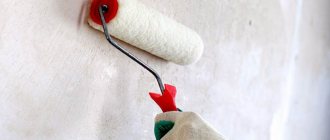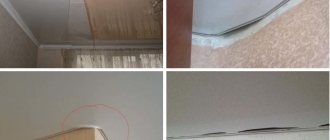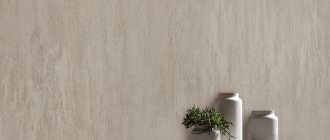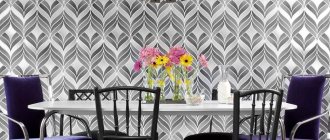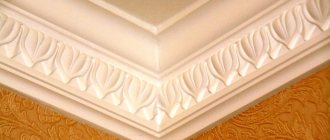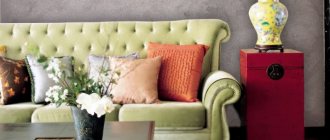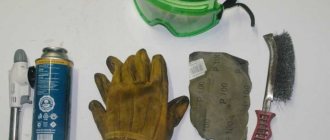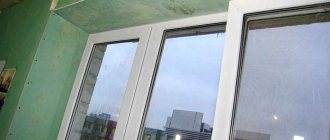Preparation
You need to assess the condition of the room. Look at the walls and decide what doesn't suit you . You can eliminate flaws and shortcomings yourself without resorting to full repairs. Even in the most difficult cases, in particular in the kitchen, you can get by without re-gluing them:
- Stains appeared on the walls.
- Bubbles appeared (read about why bubbles appear and how to glue wallpaper without swollen areas).
- Scuffs, the canvas is bent or frayed.
- The canvas comes off in several places (what to do if the wallpaper comes off?).
- Mechanical damage.
If the problem is only in the corners or edges of the strips peeling off, it will be enough to correct them (what and how can you glue old wallpaper that has come off the walls?). You need special glue or regular PVA. Usually the canvas comes off in the area of the joints (how to repair wallpaper and joints if they come apart?).
Attention
In order for the adhesive mixture to be distributed evenly, you will need to make several punctures.
Peeling off wallpaper
Often, a corner of the wallpaper peels off from the wall. A similar problem can occur at the junction of two pieces of material or around its perimeter. To return the finish to an attractive look, you need to purchase regular PVA glue, wallpaper glue, or make your own paste from flour and starch.
Wallpapering the corners
The reverse side of the detached wallpaper is cleaned of dust and debris, and glue is applied with a small brush. They also lubricate the wall in the area of delamination with adhesive. After 2 minutes, press the material to the base, carefully iron the surface with a soft cloth or roll it with a roller, removing air bubbles.
Advice! It is better to glue the peeled vertical joints of wallpaper with PVA - this way they will last longer and stronger.
About the problem
Most of us love pets very much. And in fact, they bring joy and peace to our home. Of course, different people prefer different pets. One of the most common pets today are cats. However, in addition to the joy of communicating with them, sometimes they can upset their owners. One of the most common forms of such “upset” is that the cat tears up the wallpaper. What to do in such a situation and how to stop a cat from scratching wallpaper? Most breeders face these questions sooner or later.
Let's try to figure out what way out is available in such situations and what needs to be done so that your furry pet stops gnawing and peeling not only wallpaper, but sometimes also expensive furniture.
Household tricks
To the question “how to fix a hole in the wallpaper?” more often they approach it in a simple and logical way - hide it until renovation time. Here you can come up with many ways, using items available in the house.
Use of paintings, photographs
What's the fastest way to fix a hole in wallpaper on a wall?
If damage is found near the desktop, or at a height inaccessible to children, then an excellent solution would be to decorate the area with a photograph or picture.
In the paper version, they easily “sit” on stationery or PVA glue and are secured with double-sided tape. Buttons are used less frequently. Another method involves driving a nail or screwing a self-tapping screw to hang a neat frame.
Decorating with stickers
The modern market is replete with a wide variety of decorative items with an adhesive substance on the reverse side, represented by flat and textured objects, and canvases in rolls. This is an easy way to close damage. You can also simply attach a self-adhesive hook under a towel, oven mitt, robe or jewelry.
A bit of classics
How else to disguise a hole in wallpaper? For those who like to control the minutes and keep track of dates, hanging a clock or gluing a calendar or a pen with a stand would be an excellent solution.
If you are interested in retro-style things, then a tear-off calendar with a notepad on a spring tie will be the solution.
Some may find it more interesting to attach a telephone charging unit or a traditional device with a handset.
Hanging items
The easiest way is to glue or screw in a hook. You can hang a flower pot, shelf, mirror, panel on it. It is also possible to mount a compact TV or monitor from a work computer on the wall.
For children, dart targets and basketball hoops of various formats are placed in this way.
Rearrangement of furniture
How to decorate a hole in wallpaper without paintings, stickers and clocks? This approach is good because you can make the long-awaited rearrangement and place another floor shelf. Disguising one small hole in the wallpaper will take time and physical strength. But finally there will be a reason to change the situation.
How to fix a hole in wallpaper
How to decorate wallpaper: decor options for painting and decorating old coatings
Most of us want to have an interesting and original interior in our apartment or house. Usually, the main attention is drawn to the walls, since their area is the largest, so today the article will be about how to decorate or decorate them with your own hands. There are many ways to do this, including using a wallpaper combination.
There are many ideas on how to decorate or decorate the wallpaper in a room. You can use a combination with others, paint, and various additional items. In addition, you should not immediately get rid of old coatings that have lost their appearance a little.
They can be repaired and refreshed. The video in this article will help you find additional information on this topic.
How to decorate old wallpaper?
What can be done for old wallpaper without resorting to major repairs. We are talking only about some damaged areas (otherwise the salvation of beauty will be more extensive). TO decorate an already old “canvas”, you can use other wallpapers and lay them out: figures, individual pictures, appliqué, entire panels.
On the wall you can paste pieces of wallpaper in the form of geometric shapes, or lay out a whole applique in the form of a world map, you can make a whole flower arrangement. The decor can consist of paintings that are made from a piece of wallpaper and placed in a frame. This is a healthy option. Let's focus on the application option.
1.As a design, ornaments are cut out from a piece of wallpaper; these can be flowers, rhombuses, curls.
2.Cut out the future design with sharp scissors so that the edges look neat. You can even make a sketch of the future drawing, so as not to sculpt your pieces of paper anywhere.
3.Wallpaper glue is an easy option for sticking a picture in the right place (why bother?). Use your imagination and post your original drawing or just a pattern.
You can look at examples of such decor, and you can make your own based on these ideas. It is not necessary to make the design too complicated, because our goal is to hide holes, stains or cat claw marks. In addition to manipulating pieces of other wallpaper, you can make decor from a mirror panel.
We continue to cover holes and stains on the wallpaper. For this, old scraps of unnecessary fabric are useful, which are glued to the wall in the form of an applique; ingenuity and a felt-tip pen will help us create the required design. A picture in the form of an owl and flowers is not the limit of the original execution of your idea.
You can make frames for patches from other pieces of wallpaper. Glue the damaged place on the wall to the required decor. These compositions can be decorated with butterflies made using the quilling technique. You can’t limit yourself to butterflies alone; you can develop a creative idea.
the author of the question chose this answer as the best
In general, since there is no money for repairs, you will have to somehow get out.
The easiest way is to hang a picture, a poster, or a mirror on the wall. In the absence of a picture, you can make it yourself from coffee beans, simply, easily and beautifully.
But what to do if the wallpaper is dirty or torn somewhere below or on the side, where the picture would be completely out of place?
You can also find a way out by making flowers and butterflies from white or colored paper.
The wall can be decorated with plates. Even old ones will work, but you will have to paint them yourself.
You can buy decorative stickers and add framed photos to them, it’s very beautiful and original.
I have a similar situation - a child tore out pieces of wallpaper in several places, I don’t see the point in repairing it yet, since the child is small and can still choose more than one piece of wallpaper, and I decided to stick self-adhesive pictures in place of these “damages”. Now there is a huge selection of such “applications”.
Also, the places where the cats constantly attacked were disguised with wall panels - the height is about a meter from the floor and, accordingly, along the entire perimeter.
In place of the stains, if possible, you can nail a painting, both large and small.
add to favorites link thank
In our house, it also happens that a child sometimes tears the wallpaper in some place, in this case you can use self-adhesive stickers, now there are a huge number of such stickers in the store, you can choose a self-adhesive sticker to suit your interior.
The second method is to remove some of the old wallpaper and stick photo wallpaper instead, it will turn out very original.
If the wallpaper is suitable for painting, you can draw something on it, or you can use liquid wallpaper for decoration.
DIY wallpaper decor - affordable beauty
Wallpaper stickers are the most inexpensive and effective way to decorate them. Renovating an apartment with your own hands is an exciting and responsible event, requiring a comprehensive and competent approach, both when choosing furniture and finishing materials. But what if you don’t quite like the end result? Remodeling takes time and effort, and not everyone can afford to resort to the services of professionals. Fortunately, there are many ways to enliven and decorate the interior of a room, and the most effective of them is wall decor, which you can also do yourself.
When choosing one option or another, you should start from the original color and texture of the wallpaper. Some finishing methods look more advantageous on light and plain wallpaper. others are absolutely universal.
Game of contrasts
Before you decide to replace your wallpaper, think about your decor options.
A beautiful and effective decor is obtained by combining wallpaper of various contrasting shades. The decoration made with wallpaper of the same pattern, but in different colors, looks good.
It is best to choose the place for gluing contrasting stripes so that they frame or highlight the advantages of the furniture or room. For example, you can select an area for the location of a chest of drawers, a sofa or a bed. Or, marking the middle of the wall with colored stripes, decorate the decorated area with panels. photographs or small paintings.
To create such a decor you will need:
- a roll (or several) of wallpaper;
- wallpaper glue;
- brush;
- rubber roller for smoothing wallpaper;
- narrow stucco molding for framing (length equal to double the height of the ceilings);
- polyurethane glue;
- roulette;
- ladder.
It is very important to make symmetrical markings along the floor and ceiling lines before starting work. It is important to remember that the width of the area to be decorated must be a multiple of the width of the wallpaper roll!
To prevent your kitchen wall from being boring, use wallpaper with different textures or even patterns.
You can start gluing from any edge, carefully smoothing out air bubbles and avoiding distortions. Decorative stucco is glued to the sides after the wallpaper has dried, masking the junction of two colors. Polyurethane glue sets quickly, and the plank does not require additional fixation. This vertical division of the plane visually expands the space and creates a more comfortable environment.
Combinations of colors and textures
An unusual way to decorate a room is to imitate a patchwork quilt on any of the walls.
It’s not at all difficult to make such a design solution with your own hands. The whole secret lies in combining rectangular shapes of various sizes, colors, textures and patterns.
Elements in such wallpaper can be repeated, or they can be completely unique.
To make your finished wallpaper look stylish, we recommend sticking to one color scheme.
The following materials will be required:
- multi-colored sections of wallpaper (you can also use the remains of old ones);
- wallpaper glue;
- scissors;
- brush;
- rubber roller;
- stepladder or stool.
The principle of forming a patchwork wall is that wallpaper blanks need to be glued randomly: end-to-end, overlapping and on top of each other.
A little secret: to ensure that the entire decor of the room fits into one whole, try to ensure that the interior items match the “rags” on the wall in shades or similar patterns.
Like a stencil
Stencil is the most famous device for decorating walls. Of course, a stencil pattern looks more impressive on plain wallpaper, which can highlight and emphasize the applied pattern.
The stencil design can be applied directly with a felt-tip pen. In this case, its indelibility will even be beneficial
If you use the painting method to draw a stencil, the result will be of the highest quality.
Stencils according to the method of arrangement are:
The pattern itself is most often applied with acrylic paints and, if necessary, secured with varnish. Today, for do-it-yourself interior decoration, there are many already perforated blanks and special stencil rollers that allow you to apply a single pattern to the entire wall.
Stencils can be cut out of paper, made with tape, cut out of foam rubber, or you can buy ready-made ones
A good alternative to stencils are vinyl stickers, which allow you to brightly and unusually decorate any room, from the bedroom to the kitchen. The only drawback is their high cost.
But you can develop a unique and inimitable design yourself. To create a custom stencil with your own hands you will need:
- thick cardboard;
- a simple pencil;
- stationery eraser;
- scissors.
The pattern is applied to the wallpaper using a sponge or brush and dried thoroughly.
If you want to decorate a wall with a beautiful sticker, then to create it you will need a self-adhesive film, which can be found in any hardware store. The drawn elements are carefully cut out along the contour and glued to the selected location.
If the sticker objects are large and voluminous, then you should not remove the entire base from the film at once. In this case, the paper is peeled off gradually as the composition is attached to the wall.
With just a little imagination, you can create an unusual painted story with your own hands, which will become a real decoration of the room.
Wall art
Today there is little that can surprise you, so painting wallpaper is a great way to make your kitchen more original! If you are an artist, be sure to try it; if not, find a professional
Wall painting looks expensive and impressive. The most relevant in this direction are plant and animal motifs. Being a combination of photo wallpaper and stencil pattern, the decor of this option allows you to decorate the room and leaves complete freedom for creativity. The applied drawing can be either monochrome or color, single (on one area) or on the entire wall. Be individual or complement another design solution.
The sketch of the composition is applied to the wallpaper using a pencil and is gradually filled with color using brushes of various materials and sizes. In order to highlight individual elements, you can use paint with a shimmering effect.
How to paint wallpaper with your own hands (video) In 3D effect
To make such a 3D drawing in the kitchen, you must first develop a sketch and painstakingly implement it on the wall, or simply purchase photo wallpaper. Three-dimensional decor on the walls has become incredibly popular recently. You can do it yourself using available tools:
- photo frames of various shapes and sizes;
- plant and natural elements;
- paper and cardboard blanks;
- artificial flowers.
The combination of acrylic paints with a metallic sheen and natural materials, based on the play of textures, will create an expensive home appeal.
For example, a decor with flying butterflies would be appropriate in a bedroom or nursery. And to complete it you will need:
- colored or plain double-sided cardboard;
- scissors;
- pencil;
- polyurethane glue.
To cut out butterflies you will need a stencil, which you can also make with your own hands, creating an absolutely unique shape. Multilayer elements combining woven and non-woven materials also look interesting. In this case, a lace blank is placed on the lower cardboard butterfly, and another one made of paper is placed on top, but of a slightly smaller size. All three elements are fixed in the middle with a furniture stapler and attached to the wall with glue.
You might be interested in an article on how to make a three-dimensional drawing with your own hands.
Conclusion
It is not at all necessary to spend a lot of money on materials and design services. You can give a room a bright personality yourself, the main thing is to have desire, patience and imagination!
- How to fill a hole in a wall How can you fill holes in a concrete wall? Due to various types of damage in concrete walls, it is often...
- How to repair a hole in a plastic panel How to repair a hole in plastic on a ceiling Published Without a name on January 16, 2012 –…
- How to remove bubbles on wallpaper after drying How to remove bubbles on wallpaper after drying and how to prevent their appearance You don’t dare...
- How to remove bubbles on wallpaper after gluing How to remove bubbles on wallpaper Any repair, as you know, is not only an attractive result, which...
Decorative stickers
Decorative stickers will help transform the entire wall.
Now they are sold in many stores, so finding them will not be difficult.
They look especially interesting on plain wallpaper.
Instead of stickers, colored Washi Tape will also work.
With its help you can create an interesting ornament.
Which wallpapers do not have seams visible?
On non-woven ones. They stick easily. Their canvases do not get wet or deform, since the adhesive mass is applied only to the wall surface. The joining seam is smooth and neat.
The junctions of the strips are invisible:
- with vertical print;
- squares and rectangles;
- zigzag convolutions.
Wallpaper can be hung without errors only in compliance with technological norms and rules. This is a guarantee of high-quality repairs that meet aesthetic requirements.
Updating without hassle
If the wallpaper has peeled off or is damaged only in some places, and the rest look pretty good, you can limit yourself to minor repair work with your own hands.
To do this, you need to inspect the coatings and take note of all problem areas. It can be:
- minor damage and abrasions, perhaps the canvas is bent or frayed at the outer corners;
- there are noticeable greasy stains in prominent places;
- the wallpaper has become bubbling or the joining seams have come apart and are warped in the corners;
- little artists learned to draw.
How to hide a joint contaminated with glue
Excess glue at a joint is the simplest case, but only under one condition, if you pay attention to the problem in time. If the wallpaper is glued by hired craftsmen, you will need to check the quality of the work in the first hours, while the glue is still wet.
On vinyl or non-woven wallpaper, it is enough to simply wipe the glue with a dry and clean napkin; on paper, excess adhesive material is blotted, like an ink stain, without rubbing on the canvas. After the wallpaper has dried, the joints must be checked again, since over time, glue stains tend to turn yellow and appear in the picture, after which it will be impossible to hide them.
On dark wallpaper, residual glue at the joints can be hidden using a retouching pencil. Before decorating the seams on the wallpaper in the photo, the marks are wiped off with a paper eraser.
Wallpaper painting
Painting on wallpaper will not cause difficulties even for those who are far from the art of drawing.
All you have to do is purchase a special stencil and you can start creating, armed with paint and a brush.
If someone in the family is interested in artistic painting, then they will be able to create a real masterpiece.
Gluing the joint of paper wallpaper
Seams are the most common problem with paper wallpaper. For proper gluing you need to follow certain rules:
- The wallpaper roll is unrolled and the strips that will be applied to the wall are cut out. It is necessary to leave a gap of 3-4 cm.
- Next, the cut strip is rolled out onto the clean floor, face down, and the adhesive composition is applied with a wide brush. After this, the strip is left for the time specified in the instructions for impregnation. During this period, you can prepare a second strip.
- The first strip is glued to the wall, starting from the door or window opening.
- Using a clean and dry rag, the strip is pressed against the wall, and then the remains are cut off.
- The second strip is applied with an overlap of about 30-40 mm, so that seams do not appear after drying. The whole room is glued in the same way.
Having familiarized yourself with the methods of wallpapering and how to remove seams on wallpaper after gluing, you can carry out the work yourself, it is only important to follow the rules and recommendations of the masters. For useful tips on gluing joints, watch this video:
Finally, you need to remember that each material has its own characteristics for use, so before purchasing and using it is imperative to study the composition and characteristics of the raw material.
Practice-tested ways to fix and update your decor
If there is an artist in the family who loves to paint the decor with their own hands, or the interior of the apartment is full of places where the surface of the wallpaper can become dirty from the touch of hands, outerwear, or the paws of pets, you should be prepared in advance to update their surface using a spare roll or cleaning products. Sometimes experience suggests using two-level trellises in the interior, especially in the nursery or in the kitchen-corridor.
Which wallpapers show through less on the wall?
To prevent stains of plaster, putty, construction markers from showing through the canvas, and to prevent unevenness from showing through, it is recommended to use the following wallpaper:
- paper - “duplex” and “triplex” - medium and high density;
- made of foam vinyl;
- hot stamping vinyl;
- made of solid vinyl on a three-layer paper base;
- bamboo;
- liquid.
Medium-density paper wallpaper (110-140 g/m2) “duplex” is the most profitable option - it hides wall defects well, is easy to paste and is more flexible than thick paper.
Non-woven
Coverings made of thin 100% non-woven fabric can be glued to uneven walls - they are elastic and will hide small irregularities. But the heterogeneous spotted surface of the plaster can be seen through them.
To avoid showing through areas of plaster of different colors, it is advisable to paint the walls the same color as the non-woven wallpaper.
Vinyl
In almost all cases, they hide uneven walls well. The textured pattern of foam vinyl wallpaper is ideal for rooms with uneven walls.
Before gluing vinyl wallpaper, you need to treat the walls with antibacterial impregnation to prevent the spread of mold.
Bamboo
Made from bamboo stems, natural and durable coverings can be glued to almost any surface using a special, durable adhesive. They perfectly hide unevenness, are resistant to friction, repel moisture and dust, and prevent the growth of bacteria.
Liquid
They are made from pieces of paper, dye and a binder. Such coatings can correct any wall texture. But in order to save composition, it is advisable to first seal large recesses and irregularities on the surface.
Dense embossed wallpaper with a pronounced relief is the least likely to reveal wall defects. They will cope just as well with masking the unevenness of the canvas with small patterns in the form of drops, blots, and abstract spots.
Do-it-yourself restoration of an old canvas
How to update the appearance of wallpaper without repairs? Restoration depends entirely on its texture and quality of material. You can put any old wallpaper in order without changing it, the main thing is to do it wisely and carefully. Coverages are updated in the following ways :
- Use special products to clean the surface.
- Perform periodic mechanical cleaning.
- In critical cases, do a classic retouch.
- Carefully paint it in the desired color.
- Renew damaged areas by re-gluing them in those places where guests most often come face to face with old wallpaper (how to protect wallpaper from damage?).
Elimination of defects on walls
There are times when wallpaper comes off not at the edges, but in the middle. Because of this, bubbles form on the surface. If the bubble is small, it can be eliminated without re-gluing :
- They pierce it with a needle and suck out the air.
- Then they begin to inject glue from the top with a syringe.
We talked about how to remove bubbles from wallpaper in
separate article
.
If the coating has partially come off or scratches have appeared, it is better to remove the defects this way:
- Fold back the edges of the fabric and coat with glue. For convenience, use a toothpick or match.
- Place the damaged areas in their place and smooth them with a roller. Excess glue is removed with a cloth.
- If PVA glue was used, then it needs to be heated with a hairdryer, then press down on the damaged area.
Sometimes a defective area cannot be restored (if part of the canvas is torn off). You need to glue a new piece.
- Outline the damaged area of the coating and cut it out with a utility knife.
- Then comes the preparation of the wall - putty and primer.
- Cut the sheet to the desired size, making sure that the design or pattern matches the adjacent areas.
- Coat a new piece with glue and apply it to the damaged area. Don't forget to level it with a roller.
For painting without repair
Paintable wallpaper is the easiest way to transform and update your interior. This material can be repainted several times, completely changing the appearance of the room. If you have special wallpaper in your apartment, you don’t have to remove it, but simply paint it a different color. But before painting, the canvas must be cleaned of dirt and dust with a vacuum cleaner.
Important
At least four layers of paint are applied to paper or non-woven wallpaper.
Buy acrylic or latex paint in the store, and if desired, add color to dilute the color. During painting, the material is carefully leveled over the entire surface with smooth up/down movements. If after the first layer it was not possible to paint over greasy stains or abrasions, then you need to apply the next layer.
Why do joints appear?
Unpleasant situations with joints happen when hanging wallpaper of all types. Their development is provoked by:
| Cause | Remedy |
| Violation of transportation rules and storage requirements. This is indicated by damaged packaging film of rolls, wrinkled and torn edges. | Wallpaper must be carefully loaded into and unloaded from the car. Store rolls in an upright position. Before gluing, trim off crumpled and torn areas. |
| Poorly prepared surface. | Thoroughly clean the surface to be pasted. Level by applying putty. |
| Glue that does not match the type of wallpaper. | Choose an adhesive composition that matches the type of wallpaper. The packaging is marked with the following inscriptions: “For all types of paper”, “For vinyl”, “For heavy”, “Special non-woven”. |
| Uneven distribution of glue. | Apply glue with a brush. Spread over the sheet with a rubber roller. The quality of gluing is negatively affected by excess and lack of glue. |
| Failure to follow manufacturer's instructions. | Strictly follow the recommendations on the roll label regarding the method and amount of glue applied, pattern alignment, and drying time. |
| Lack of skills. | Before starting work, you need to carefully study the instructions. Make markings on the wall for each sheet using a level, plumb line, metal ruler and pencil. When preparing the canvases, carefully measure their length. Start gluing from inconspicuous areas, constantly check the accuracy of the placement of the panels in the vertical plane. |
Defects manifest themselves in different ways. Typically, a visual inspection of butt seams reveals:
- The edges of the panels glued end-to-end have diverged by 2-3 mm;
- Hardened glue residues on the front side of the edges;
- Sheets that have peeled off along with the putty;
- Uneven cut;
- Uneven coloring of the edge part (if the wallpaper is painted after gluing).
Liquid and paper webs
Liquid wallpaper is a material with amazing properties and an interesting method of application (you can learn more about what liquid wallpaper is, how to properly dilute and apply it here). But over time, such a canvas can become damaged, which means it needs restoration. They can be quickly restored and repaired with your own hands. You need to stock up on a basic set of tools and a new composition for the job in advance.
- To restore the coating, it is necessary to dilute the mixture and leave it to infuse for some time.
- When the mixture is wet, carefully cover the gaps in the walls with a trowel in small portions.
Before updating, you need to make sure that the coating is resistant to abrasion and wet cleaning. It is important to keep in mind here that the paper web will have to be varnished, otherwise the coating will quickly deteriorate.
If stains appear on the paper, it will be difficult to get rid of them, but it’s worth a try:
- It is necessary to attach a white napkin and iron it.
- If this does not help, cut out the contaminated area and replace it with a new one.
Why does wallpaper show through?
Not everyone in the store thinks about how finishing materials will behave in their work, falling for their attractive appearance. But knowing the properties and features of different types of finishes is necessary to obtain an excellent result.
There are several reasons that can cause the effect of wallpaper on the wall to show through:
- material too thin;
- the canvases are designed for further painting;
- low quality glue used;
- The surface to be glued is not sufficiently prepared.
If the wallpaper is too thin
Before gluing thin, light-colored materials, it is necessary to carefully prepare the walls, otherwise unevenness and various defects of the plaster will appear through the delicate canvas. You can determine whether the coating will be translucent in the store; just put a bright picture under it.
The thinnest of all wallpapers, which will certainly reveal defects in the walls during repairs, are single-layer paper “simplex” and thin vinyl with a non-woven backing.
When purchasing paper wallpaper, it is important to consider the quality of the paper. If it is loose and loose (up to 110 g/m²), you should not expect a good result from the repair.
Canvases are intended for painting
The material is very thin due to the translucent base made of non-woven fabric or paper. Such canvases are not intended for gluing in a “bare” form - they must be covered with one or several layers of paint.
Low quality glue
Cheap wallpaper paste, passed off as an “analogue” of a popular brand, also risks causing stains. It may not be as good as the store clerk described it. Due to the low quality of the glue, it often comes out during the polymerization process, which leads to the formation of streaks and yellow spots on the coating.
To avoid mistakes, it is better to buy glue from well-known manufacturers.
Poorly prepared surface
If the panels were not leveled with special compounds and were not completely cleared of old coatings, the gluing result is almost always unsatisfactory. Depressions, irregularities and bumps in walls are clearly visible on light-colored materials. On particularly neglected surfaces, even dark thick wallpaper will not mask defects.
Troubleshooting
If the outer corners are bent or frayed, you can use a plastic corner that matches or contrasts with the main wallpaper. It is easy to glue it with your own hands by choosing the appropriate adhesive composition.
If a large area is scuffed or damaged, you need to cut out the piece of wallpaper needed for gluing from the remaining piece of wallpaper after the repair, carefully aligning it according to the pattern. Carefully cut out the old one with a sharp knife, and glue the new, selected one.
If there is no wallpaper left, then there is a way out in this case too. You can glue a colorful sticker and paint it, framing it with moldings.
In case of greasy stains, washable wallpaper is treated with a sponge, using a soap solution or other grease remover. If they are present on paper wallpaper, they are treated with salt or starch and then brushed off with a soft brush.
If bubbles form on the wallpaper, they should be pierced with a needle and all the air should be expelled. Then dilute the adhesive solution a little thinner than usual and pump it under the wallpaper with a syringe. Then carefully smooth the surface.
If the joints have come apart, the easiest way is to buy a special compound in tubes. They are sold in building materials stores and are inexpensive. How to update the walls is shown in the photo:
If there is loose wallpaper in the corners, it is best to spread it apart, clean off any stuck pieces of putty, coat it twice at intervals of 5-10 minutes, and when the base gets wet and becomes elastic, glue it to the old place, trying to press it tightly and without bubbles to the wall.
After the creativity of little ugly people, drawings with a felt-tip pen, pencils or marker are often left behind.
An ordinary pencil can be easily erased with an eraser. You can try to remove serious creativity with felt-tip pens with alcohol or gasoline.
In hardware stores you can purchase special wet wipes for removing stains or liquid for removing stains. All these methods are good for updating, with minor damage, old wallpaper. How to update the interior is shown in the photo:
How to fix joints on wallpaper
There are several methods for eliminating mistakes and masking butt seams.
- Glue decorative strips or fragments of wallpaper, matching the pattern.
- Re-glue the areas with errors. Spray them with hot/warm water using a spray bottle. Let it swell. Remove from the wall with a spatula. Apply glue for butt borders. Secure with a narrow roller.
- Color over the border areas with a pencil of a suitable color or marker. You can use grout for ceramic tiles, adding color to it until you get the desired shade.
- Decorate by installing moldings.
How to remove overlap
To get an even joint when gluing using the “Overlap” technology, you need to remove the overlap in a timely manner:
- The sizing area is allowed to dry for 9-10 hours (complete drying is not allowed).
- Using a pencil and a metal ruler, draw a clear line.
- An even cut is made along it with a sharp stationery knife or blade.
- The cut strip is carefully torn off.
An overlap that appears on a dried butt-glued surface can be corrected as follows:
- The joint boundaries are wetted with water.
- Kept in a wet state until it swells.
- The wall and edges are coated with a quick-setting adhesive mixture.
- The edges are aligned and secured in the desired position.
Overlaps appear when paintings are applied to the wall without checking the vertical with a plumb line or level.
How to fit a drawing
Canvases with a large, clear pattern are joined. This operation is performed taking into account the size of the picture. Manufacturers indicate these parameters on the packaging.
Procedure:
- The canvas is spread on the floor face up.
- The length of the first strip is measured and cut.
- The next one is placed along it, combining the elements of the ornament.
- The excess is trimmed off.
- Each subsequent strip is adjusted in the same way.
Trimmings can be used to repair defects in inconspicuous areas. They are also useful for pasting areas above windows and doorways.
Combination
If the lower or upper part of the wallpaper is completely damaged, you can join it with the remains of other wallpaper.
To do this, you need to stick masking tape around the entire perimeter of the area being replaced and use a knife to remove a piece of unsuitable fabric.
Glue new wallpaper in its place.
How to hide torn material?
Quite old wallpaper can peel off, and torn material can hardly be called interior decoration. If this happened on top or on the sides of the canvas, then it will be enough to glue the wallpaper to the wall.
Attention
Attention! When re-gluing, it is necessary to saturate the edges of the canvas with glue. If the wallpaper is thick, then more glue is required.
If it is impossible to seal up tattered wallpaper, for example, torn by a cat, then you can decorate it with various materials, or temporarily cover it with furniture. If the damage is small, then you can cut out a piece of torn wallpaper and glue a fresh one in its place.
Mold on and under wallpaper
If the room is very humid, then such unpleasant “neighbors” as fungus and mold may appear on the surface of the wall. It is not at all easy to evict both of them, but it is possible. It's easy to spot mold under wallpaper - dark spots will appear on it.
Mold on wallpaper - only plywood will help
Unfortunately, such wallpaper will have to be completely removed in the place where it covered the fungus. And the wall itself will need to be thoroughly cleaned of fungus, using all kinds of antiseptics. And fresh wallpaper (it’s good if you have pieces to match) should be glued with glue containing antibacterial substances.
Important! Remember that mold in an apartment is not only a source of unpleasant odors, but also an organism that harms your health! Therefore, it is imperative to get rid of it.
What to do if the wallpaper is see-through
If the unpleasant effect of translucence is revealed at the initial stage of work after gluing 1-2 canvases, and it is not possible to cover them with furniture or decorate them, then it is worth removing the pasted wallpaper and leveling the surfaces of the walls. It’s better to buy one roll and work a little extra than to worry about the whole room being ruined.
- The uneven color of the panels can be evened out by painting them with liquid water-dispersion paint using a roller, and after drying, pasting them over again.
- Another simple option is to level the walls with a high-quality primer, such as Tikkurila Varma, which has pigment added to give it a color that matches the tone of the wallpaper. This primer is easy to apply, compares the absorbency of different textures, and does not become wet from water or glue.
If the see-through appears later, when the entire room has already been covered with wallpaper, you can try other options to solve the problem.
Vinyl
You can paint them with acrylic or dispersion paint to match. The paint adheres well to the vinyl surface and will even help give the interior a new look.
Non-woven
It all depends on the type of canvas - if it is non-woven wallpaper for painting, then 2-3 layers of paint applied on top will definitely solve the problem. If the finish is not intended for painting, the coating will have to be changed.
Paper
It is not advisable to paint such materials or seal them with other layers on top - the thin fabric will get wet and the situation will become even worse. You can consider decorating the spots using appliqués, panels, or other solutions (paintings, watches, photographs). If none of the above is suitable, all that remains is to change the wallpaper to a denser one, or level the walls.
Shines through wallpaper for painting
If the coating was glued to a poorly prepared surface, and after painting all the irregularities and stains appeared, you will have to apply two or more additional layers of paint on top to eliminate the problem.
Don't worry in advance if the paint hasn't dried yet. It will become more uniform after drying completely.
Have you encountered the problem of wallpaper showing through after hanging?
Yes
No
Joining combined wallpaper
Among the decoration of a room with materials of different patterns and shades, three methods of combination can be distinguished:
- the walls are divided horizontally. With this option, most often the border is decorated with special inserts (decorative borders). The canvases are glued end-to-end;
- An interesting room decor is obtained by vertically alternating stripes of different wallpapers. If the connection lines are vertical, then the panels are glued end-to-end. Sometimes the border can be wavy. At the same time, they practice attaching wallpaper overlapping (to the width of the bends). Then, with a sharp knife, two canvases are cut simultaneously along the zigzag line. This design technique is appropriate to use when gluing materials of the same texture (the best option is wallpaper from the same manufacturer);
- an extraordinary patchwork combination involves fixing the wallpaper with an overlap. This decoration option looks original when choosing companion paintings (decorated in the same style).
Combining wallpaper is a very exciting process. To ensure that the result of the repair does not disappoint, it is recommended to select materials that differ only in shade or pattern.
Style combination
You can choose wallpaper according to your style in contrast or continuation:
If you want new sensations, experiment with contrast.
If you are more conservative, choose wallpaper in a single style combination to match the entire decor.
If your feelings are average—you want something new, but are not ready for drastic changes—use similar style combinations with little contrast.
Decorator Emily Henderson in her book “Style” uses a style circle for examples of combining styles:
How to combine wallpaper by style in accordance with the style circle:
Contrasting combination of styles. This is a combination of opposing styles in one room, or elements of styles. The most contrasting pairs will be those opposite each other in the style circle.
For example, wallpaper for a kitchen with a seventies design combined with Scandinavian style:
Wallpaper BN International Stitch 219051
Close style combination. Related styles move clockwise from Scandinavian and ends with Classic. You can also take advantage of the natural historical course of style formation. To do this, you need to stock up on knowledge about the history of styles, for example in the style history section of our blog, or consult with a designer.
Wallpaper BN International Riviera Maison 18321
A single style combination. This is the use of wallpaper of the same style as the entire decor, but with changes made to enhance or refresh the previous image. If the kitchen is made in the Provence style, you can change the patterns on the wallpaper: there were small flowers, let there be stripes, or wallpaper in the Toile de Jouy style. And an aged kitchen set will only bring you closer to the real Provence.
The good thing about the theory of style combinations is that you can introduce ideas and achieve interesting changes without major alterations.
Wallpaper of a different color
The easiest option is to replace the damaged piece of wallpaper. It’s good if after the last repair there was a spare roll of the same color. Carefully cut the damaged piece from the wall and glue a new one. If there is a pattern, make sure it matches.
When there is no stock left, select similar or contrasting wallpapers and make an insert from them. How exactly to glue depends on the location of the defect and the imagination of the craftsman. You can use whole canvases or small pieces. The inserts can be horizontal, along the entire length of the room, or vertical, in one or more stripes:
- Was the wallpaper below torn off by cats, painted on by small children? Stick others, height from the floor and to a place just above the damage. For example, if the entire wall is decorated with small flowers, put striped wallpaper underneath, matching the color or plain;
- Is there a long horizontal scuff left in a visible place from furniture, such as a crib? Make a wide border of wallpaper;
- if a large area has been badly damaged, cover the wall with bright pieces of old wallpaper using the patchwork technique. This is done according to the same principle as patchwork quilts are sewn. Select and arrange them on the wall. You can combine different textures and patterns in the same color scheme, different palettes of the same theme (for example, floral), sizes and shapes of fragments;
- Vertically applied stripes of contrasting color wallpaper will not only hide defects, but will also become a bright accent on the wall. They can even be glued to the ceiling. And if you decorate it with polyurethane moldings, you will get an original panel.
On what basis do repairs begin?
Before starting the restoration of materials, the master finds out the cause of the surface damage. When it becomes clear why the scratches appeared on the corrugated sheeting, it will be easier to determine the scope of work and choose the repair method. The owner can proceed with adjustments based on:
- damage to sheets due to poor transportation;
- the appearance of chips due to improper use;
- damage during installation;
- changing surface color to improve design;
- corrosion processes;
- updates of appearance according to service life.
From time to time, the profiled sheet needs repairs or mechanical damage helped, so you need to prepare to start work. Then you won’t have to stop searching for parts at the most crucial moment.
( 1 rating, average 5 out of 5 )
Removing edge curl on seams and evening out color
Curling edges must be coated with glue again.
If the preparation of the wall surface was carried out poorly, then after gluing the wallpaper, the seams may lag behind the walls and curl. At the same time, some of the plaster remains on the edges. This problem appears if low-quality materials were used, which means you shouldn’t skimp on surface preparation.
The defect can be eliminated by gluing the seams with joint glue. After applying the composition, you need to secure the canvas with a spatula or rubber roller.
Often, wallpaper may not match in shade on different edges. If you unwind the roll, the differences will be unnoticeable, but when gluing the walls, defects appear, the seams are obtained with sharp color transitions, which can be noticed without any problems.
Reversible pasting will help prevent this effect. In other words, one canvas is glued as usual, and the second is turned over and only in this state is applied to the wall. For more information on how to glue joints, watch this video:
If the work has already been done and such a defect has appeared or uneven cuts at the joints are visible, then painting the seams will help hide the defect. To do this, you can buy a special product in the store or use a regular pencil. The main thing is to choose the right shade. Uneven joints due to incorrect cuts can be covered with decorations: edgings, ribbons, etc.
Studying the instructions for the wallpaper will help you avoid correctional work. Manufacturers can write gluing procedures for different types of materials.


